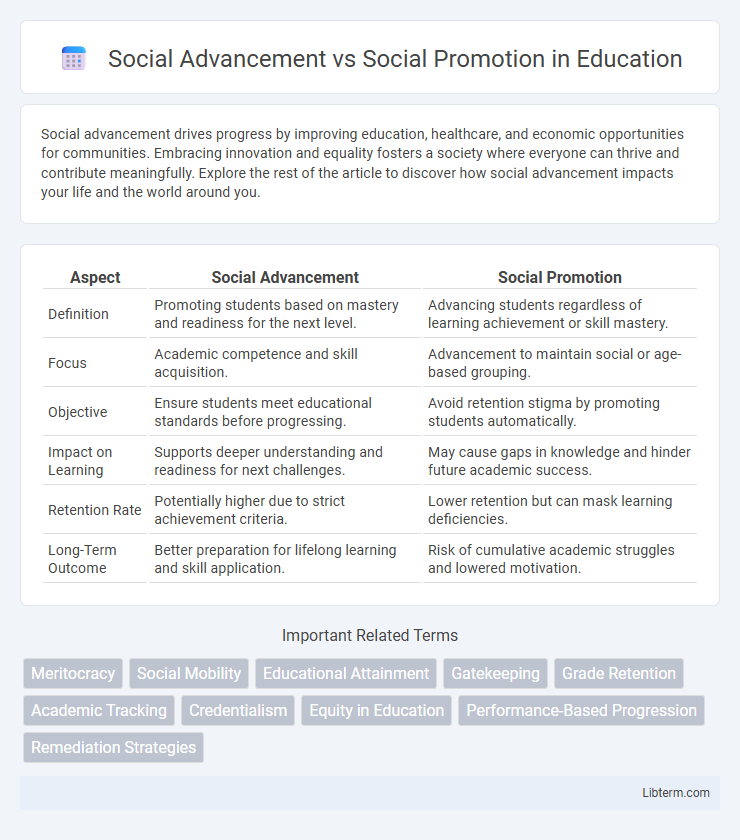Social advancement drives progress by improving education, healthcare, and economic opportunities for communities. Embracing innovation and equality fosters a society where everyone can thrive and contribute meaningfully. Explore the rest of the article to discover how social advancement impacts your life and the world around you.
Table of Comparison
| Aspect | Social Advancement | Social Promotion |
|---|---|---|
| Definition | Promoting students based on mastery and readiness for the next level. | Advancing students regardless of learning achievement or skill mastery. |
| Focus | Academic competence and skill acquisition. | Advancement to maintain social or age-based grouping. |
| Objective | Ensure students meet educational standards before progressing. | Avoid retention stigma by promoting students automatically. |
| Impact on Learning | Supports deeper understanding and readiness for next challenges. | May cause gaps in knowledge and hinder future academic success. |
| Retention Rate | Potentially higher due to strict achievement criteria. | Lower retention but can mask learning deficiencies. |
| Long-Term Outcome | Better preparation for lifelong learning and skill application. | Risk of cumulative academic struggles and lowered motivation. |
Understanding Social Advancement and Social Promotion
Social advancement refers to the process where individuals progress based on demonstrated skills, knowledge, and merit, ensuring that each step in their development is substantiated by actual achievement. Social promotion involves advancing individuals to the next level despite inadequate performance, often to maintain social harmony or avoid negative labeling. Understanding the distinction between social advancement and social promotion is critical for developing effective educational and organizational strategies that promote genuine growth and equitable opportunities.
Key Differences Between Social Advancement and Social Promotion
Social advancement involves promoting students based on mastery and demonstrated understanding of curriculum content, ensuring readiness for more challenging material. Social promotion advances students to the next grade level regardless of academic achievement, often to maintain age-grade alignment. The key differences lie in evaluation criteria, with social advancement emphasizing skill competency and social promotion prioritizing social or developmental factors over academic performance.
Historical Context of Social Promotion in Education
Social promotion emerged in the mid-20th century as an educational policy aimed at advancing students to the next grade level regardless of mastery to maintain self-esteem and social development, particularly during the post-World War II era when educational access expanded rapidly. Historical data reveals that social promotion was intended to reduce dropout rates and address diverse classroom needs amid increased student population growth and civil rights movements advocating for equal opportunities. Critics argue that this practice led to academic underperformance and widened achievement gaps, sparking reforms in the 1980s and beyond to re-emphasize mastery-based advancement.
Benefits of Social Advancement for Student Development
Social advancement fosters genuine student development by promoting mastery of essential skills before progressing to more complex concepts, ensuring a solid academic foundation. It enhances critical thinking, self-confidence, and long-term retention by allowing students to fully grasp subjects at their own pace. This approach supports emotional growth and motivation by reducing frustration and building resilience through achievable milestones.
Challenges and Criticisms of Social Promotion
Social promotion faces significant challenges such as undermining academic standards, as students advance without mastering essential skills, leading to gaps in knowledge and preparedness for higher education or the workforce. Critics argue it contributes to lowered motivation and accountability, as students may perceive less incentive to improve if automatic promotion is guaranteed. Furthermore, social promotion can strain resources by requiring remedial interventions in subsequent grades, impacting overall educational quality and equity.
Academic Implications of Advancing vs. Promoting Students
Social advancement, grounded in mastery of academic content, fosters long-term educational success by ensuring students build essential skills before moving forward. Social promotion advances students regardless of academic readiness, often leading to gaps in knowledge and increased challenges in subsequent grade levels. Research indicates that prioritizing academic achievement over automatic grade progression results in higher retention of core competencies and better preparedness for future academic demands.
Effects on Student Motivation and Self-Esteem
Social advancement fosters genuine skill development by promoting students based on mastery of content, which enhances intrinsic motivation and boosts self-esteem through measurable achievement. In contrast, social promotion advances students regardless of readiness, often leading to gaps in knowledge that reduce motivation and erode self-confidence due to repeated struggles. Empirical studies link social advancement with improved academic outcomes and higher levels of student engagement, while social promotion correlates with increased dropout rates and diminished self-worth.
Long-Term Outcomes for Socially Promoted Students
Socially promoted students often exhibit lower academic achievement and increased dropout rates compared to those who advance through mastery-based social advancement. Long-term outcomes reveal that social promotion can hinder skill development and limit future career opportunities, perpetuating educational inequities. Research indicates that targeted interventions and support systems yield better success in fostering sustained academic and social growth.
Educational Policy Perspectives on Advancement and Promotion
Educational policy perspectives emphasize social advancement as a merit-based progression system where students advance by mastering academic standards, ensuring readiness for subsequent grade levels. In contrast, social promotion allows students to move to the next grade despite insufficient academic achievement, often aiming to maintain age-grade alignment but risking learning gaps. Policymakers debate these approaches, balancing the benefits of academic rigor inherent in social advancement against the socio-emotional impacts associated with social promotion.
Best Practices for Balancing Advancement and Promotion
Effective social advancement integrates targeted skill development and measurable achievements, ensuring individuals progress based on merit and competence. Social promotion, often used to maintain peer relationships, requires careful assessment to avoid undermining standards, emphasizing support systems like tutoring and mentorship. Best practices balance advancement and promotion by combining clear performance metrics with personalized interventions, fostering both academic growth and social well-being.
Social Advancement Infographic

 libterm.com
libterm.com